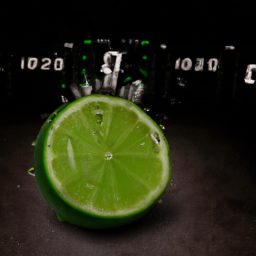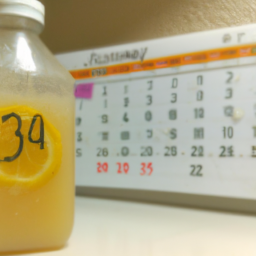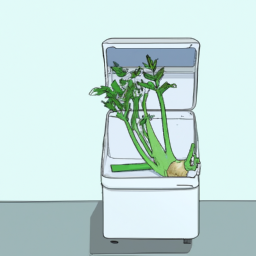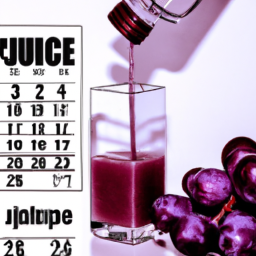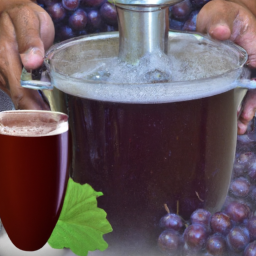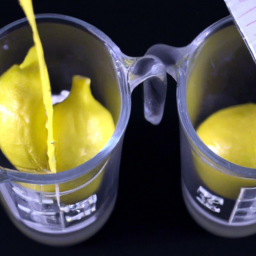As someone who loves experimenting with different flavors in the kitchen, I often find myself with leftover lime juice after squeezing. I am always curious about how long this lime juice will stay fresh in the fridge before it spoils and becomes unusable. It is important to me to not waste a valuable ingredient or put myself at risk of getting sick from using spoiled lime juice.
Proper storage and handling of squeezed lime juice is crucial in order to extend its shelf life and ensure its safety for consumption. There are various factors that can affect how long squeezed lime juice lasts, including temperature, exposure to air, and the presence of bacteria.
In this article, we will explore these factors and provide tips for extending the shelf life of squeezed lime juice, as well as how to tell if it has gone bad and the potential health risks of consuming spoiled juice.
Key Takeaways
- Proper storage is crucial for maintaining the shelf life of squeezed lime juice.
- Signs of spoilage include a yellow/brown hue and sour/fermented odor.
- Freshly squeezed lime juice can last up to a week in the refrigerator and up to 6 months when frozen in ice cube trays.
- Spoiled lime juice can cause health risks and should be properly disposed of to prevent harm to the environment.
Importance of Proper Storage for Squeezed Lime Juice
You need to make sure you’re storing your squeezed lime juice properly, or it won’t last as long as you want it to. Proper storage techniques are key to preventing waste and ensuring that your lime juice stays fresh for as long as possible.
The first thing to consider is the container you’re using. Glass containers are the best option, as they don’t react with the acid in the juice and won’t affect the flavor. Plastic and metal containers should be avoided, as they can leach chemicals into the juice and cause it to spoil more quickly.
Once you’ve chosen your container, be sure to store your lime juice in the refrigerator. This will slow down the oxidation process and help to preserve the quality of the juice. Additionally, make sure the container is tightly sealed to prevent air from entering and causing the juice to spoil.
By following these simple steps, you’ll be able to keep your lime juice fresh and ready to use for longer. Now, let’s explore the factors that can affect the shelf life of lime juice.
Factors Affecting the Shelf Life of Lime Juice
When considering the shelf life of squeezed lime juice, there are several factors to take into account.
First and foremost is the freshness of the lime. The older the lime, the less juice it will produce and the shorter its shelf life will be.
Additionally, the type of container used to store the juice can have a significant impact on its shelf life, as can the temperature and humidity of the storage environment.
So, it’s important to keep these factors in mind when storing lime juice to ensure it stays fresh for as long as possible.
Freshness of the Lime
Feeling thirsty for a zesty lime refreshment? Before you grab that lime, it’s important to know that the freshness of the lime can impact how long its juice will last. Using fresh lime juice not only adds a tangy flavor to dishes and drinks, but it also provides many health benefits. Lime juice is rich in vitamin C, antioxidants, and can aid in digestion and weight loss.
To ensure the longest shelf life for lime juice, it’s best to use fresh limes that are firm and have a smooth, shiny skin. When a lime is fresh, the juice is more potent and flavorful, and it can last longer. Check for any signs of decay, such as discoloration or soft spots, as this can affect the quality of the juice. Using fresh limes not only enhances the taste of your dishes and drinks, but it also provides added health benefits that may not be present in lime juice that has been sitting for an extended period of time.
The type of container used is also an important factor in determining the shelf life of lime juice. Let’s explore this in the next section.
Type of Container Used
The type of container utilized greatly influences the longevity of the tart and healthy lime juice. In order to make the most out of your freshly squeezed lime juice, it’s important to know the best storage practices that will preserve its freshness and nutritional value.
Here are some container options that are ideal for storing fresh lime juice:
-
Glass containers are the best option for storing fresh lime juice as they don’t react with the acid in the lime juice, ensuring that the juice remains fresh and healthy.
-
Plastic containers are also a good option, but it’s important to make sure that the container is made of food-grade plastic that’s BPA-free and won’t leach any harmful chemicals into the juice.
-
Stainless steel containers are also a good option, but they’re not as popular as glass or plastic containers. They’re durable and won’t react with the lime juice, making them a good choice for storing fresh lime juice.
By following the best storage practices and choosing the right container, you can extend the shelf life of your freshly squeezed lime juice. However, the container is just one factor that affects the longevity of lime juice. The temperature and humidity of the storage area also play a crucial role in preserving the freshness and nutritional value of lime juice.
Temperature and Humidity
Maintaining proper temperature and humidity levels is crucial for preserving the freshness and nutritional value of your freshly squeezed lime juice. Lime juice should be stored in an airtight container and refrigerated immediately after squeezing to prevent bacterial growth.
The ideal temperature range for storing lime juice is between 32°F to 40°F, as this slows down the rate of spoilage. While it’s possible to freeze lime juice, it’s not recommended as freezing can alter the flavor and texture of the juice. Additionally, freezing can cause the juice to lose some of its acidity, which is essential for preserving its freshness.
It’s best to consume lime juice within a few days of squeezing it for optimal taste and nutritional value. As a result, it’s important to monitor the temperature and humidity levels of your storage area to ensure that your lime juice remains fresh and safe to consume.
In the next section, we’ll discuss how to identify signs of spoilage in squeezed lime juice.
Signs of Spoilage in Squeezed Lime Juice
If you notice any unusual colors or smells in your squeezed lime juice, it’s time to toss it out. Spoiled lime juice can have a yellowish or brownish hue, and it can emit a sour or fermented odor. Once you detect any of these signs, it’s best to discard the juice to avoid any potential health risks.
However, don’t be too quick to throw away your lime juice if it’s only slightly past its prime. There are ways to repurpose spoiled lime juice, such as using it as a marinade or adding it to your cleaning solution.
On the other hand, fresh lime juice can be used for a variety of alternative purposes, from enhancing the flavor of your cocktails to adding a zesty tang to your dishes. As long as your lime juice is still good, you can enjoy its many uses.
When it comes to how long squeezed lime juice can last in the refrigerator, there are several factors to consider.
How Long Can Squeezed Lime Juice Last in the Refrigerator?
After learning about the signs of spoilage in squeezed lime juice, it’s important to understand how long it can last in the refrigerator. This will help prevent any waste and ensure that you can use it in your cooking and recipes without any health risks.
Here are some key points to keep in mind when storing squeezed lime juice in the refrigerator:
- Freshly squeezed lime juice can last for up to a week in the refrigerator.
- If you want to extend the shelf life, you can freeze the juice in ice cube trays and store them in a freezer bag for up to six months.
- Make sure to store the juice in an airtight container to prevent any oxidation or contamination.
Consuming lime juice has a variety of health benefits, including improving digestion, boosting the immune system, and aiding in weight loss.
By understanding how long squeezed lime juice can last and the benefits of consuming it, you can make the most out of this versatile ingredient in your cooking and recipes. But if you want to further extend its shelf life, there are some tips and tricks you can follow.
Tips for Extending the Shelf Life of Squeezed Lime Juice
To keep your freshly squeezed lime juice from going bad too soon, try storing it in an airtight container and keeping it in the fridge. This will help extend the shelf life of your juice by a few days.
Another tip is to use the ‘squeeze every last drop’ idiom to get the most out of your citrus. This means using a citrus juicer or squeezer to extract as much juice as possible from your limes. By doing so, you’ll have more juice to store and use, which means less waste.
If you’re looking for creative recipes to use your freshly squeezed lime juice in, there are plenty of options. Lime juice is a versatile ingredient that can be used in both sweet and savory dishes. It’s a key ingredient in many cocktails, including margaritas and mojitos, and it’s also great in marinades, dressings, and sauces.
Alternative uses for leftover lime juice include using it as a natural cleaner or deodorizer, or adding it to your bathwater for a refreshing soak.
With so many uses for lime juice, there’s no reason to let any go to waste.
Uses for Leftover Lime Juice
Now that you know how to extend the shelf life of squeezed lime juice, let’s talk about ways to use any leftover juice. Don’t let that precious lime juice go to waste!
There are plenty of delicious recipes and practical uses for the remaining juice that you can try out. First on the list, you can use your leftover lime juice to make marinades for meat or fish. Lime juice adds a zesty and tangy flavor that can help to tenderize the meat, making it perfect for grilling or baking.
Another great way to use leftover lime juice is to add it to your favorite cocktail recipes. Margaritas, mojitos, and other citrus-based drinks all benefit from a dash of lime juice. Lastly, you can use your leftover lime juice to make salad dressings or even add it to guacamole for an extra kick of flavor.
With so many ways to use leftover lime juice, you’ll never have to worry about it going to waste again. Now that we’ve covered the various ways to use leftover lime juice, it’s important to know when it’s time to throw it away.
In the next section, we’ll discuss how to tell if lime juice has gone bad.
How to Tell If Lime Juice Has Gone Bad
Don’t risk a sour taste and potential health hazards by using lime juice that’s gone bad! It’s important to know how to tell if lime juice has gone bad, especially if you have a batch that’s been sitting in the fridge for a while.
Lime juice can last for a few days to a week if stored properly, but it can go bad quickly if not handled correctly. One of the best methods to preserve lime juice is to freeze it in ice cube trays. This way, you can have lime juice readily available for future use without worrying about it going bad.
Another method is to store it in an airtight container in the fridge, making sure to use it within a few days. If you’re not sure if your lime juice has gone bad, check for any signs of mold or a foul smell. If it doesn’t smell fresh or has any visible signs of spoilage, it’s best to discard it.
Alternatively, if you have expired lime juice, you can use it for alternative purposes such as marinades, salad dressings, or cleaning agents. Remember, using spoiled lime juice can lead to potential health risks such as food poisoning and upset stomachs.
It’s better to be safe than sorry, so make sure to properly store and handle your lime juice to prevent it from going bad. In the next section, we’ll discuss the health risks associated with consuming spoiled lime juice.
Health Risks of Consuming Spoiled Lime Juice
Consuming spoiled lime juice can result in serious health risks, including food poisoning and stomach upset. Symptoms of consuming spoiled lime juice may include nausea, vomiting, diarrhea, and abdominal pain. These symptoms typically appear between 30 minutes to 6 hours after consuming the spoiled juice. If you experience any of these symptoms, it’s important to seek medical attention immediately.
Treatment for consuming spoiled lime juice typically involves rehydration through drinking fluids and electrolyte replacement. In severe cases, hospitalization may be necessary. Prevention and precautions include checking the expiration date of the lime juice before use, storing it properly, and discarding any leftover juice after use.
It’s important to always follow proper food safety guidelines to prevent the risk of illness from consuming spoiled food or beverages. Proper disposal of spoiled lime juice is important to prevent contamination and further health risks.
Proper Disposal of Spoiled Lime Juice
Ensuring safe and proper disposal of spoiled lime juice is crucial in preventing contamination and potential health risks. When lime juice goes bad, it can harbor harmful bacteria that can cause food poisoning. Additionally, the sour smell and taste can indicate that the juice has gone bad, making it unappetizing to consume. Proper disposal of spoiled lime juice also has an environmental impact, as improperly disposed of juice can contribute to pollution and harm wildlife.
To properly dispose of spoiled lime juice, it is important to first pour it into a sealed container, such as a plastic bottle or jar. This prevents the juice from leaking and contaminating other surfaces or waste. Next, label the container as "spoiled lime juice"to ensure that it is not mistaken for a usable product. Finally, dispose of the container in the appropriate waste bin. In some cases, it may be necessary to contact a hazardous waste disposal service if the juice was contaminated with chemicals or other harmful substances. By following these proper disposal techniques, we can prevent potential health risks and minimize our environmental impact.
| Advantages of Proper Disposal of Spoiled Lime Juice | Impact on the Environment | ||
|---|---|---|---|
| Prevents contamination and potential health risks | Reduces pollution and harm to wildlife | ||
| Ensures safe and responsible waste management | Prevents the spread of harmful bacteria | ||
| Minimizes unpleasant odors and taste | Protects the environment for future generations | ||
| Promotes cleanliness and hygiene | Encourages responsible consumption and disposal habits | Reduces the risk of water contamination and pollution. |
Frequently Asked Questions
Can you freeze squeezed lime juice to extend its shelf life?
Freezing lime juice is a fantastic way to extend its shelf life indefinitely. I often freeze squeezed lime juice and use it in various lime juice recipes, such as margaritas, marinades, and dressings.
Is it safe to consume squeezed lime juice past its expiration date?
Consuming expired squeezed lime juice poses health risks due to the growth of harmful bacteria. Lime juice preservation techniques include refrigeration, freezing, or adding preservatives. Always check expiration dates and discard if expired.
How does the shelf life of squeezed lime juice compare to bottled lime juice?
When comparing squeezed lime juice to bottled lime juice, there are several factors to consider such as storage methods and quality. Bottled lime juice typically has a longer shelf life due to its pasteurization process and sealed packaging.
Can you mix squeezed lime juice with other ingredients to make it last longer?
Preservative methods can extend the shelf life of squeezed lime juice. Adding citric acid, salt, or sugar can help. Flavor combinations include ginger, honey, and mint. Always refrigerate and discard if mold appears.
How do you properly clean and sanitize the container used for storing squeezed lime juice?
Cleaning and sanitizing the container for storing squeezed lime juice is crucial for preventing bacterial growth. Use hot water and soap to clean glass or plastic containers, and sanitize with a solution of one tablespoon bleach per gallon of water.
Conclusion
In conclusion, properly storing and handling squeezed lime juice is crucial in maximizing its shelf life and preventing foodborne illnesses. It’s important to take necessary precautions such as refrigeration and sealing the container tightly to combat factors such as temperature, exposure to air, and acidity affecting its deterioration.
Leftover lime juice can be used for a variety of purposes such as marinades and cocktails, but it’s important to check for signs of spoilage before consuming. Just like a lime that has lost its zest, spoiled lime juice can leave a sour taste in your mouth and pose health risks. Don’t let that happen and make sure to dispose of any spoiled lime juice properly.
With these tips, you can enjoy the refreshing taste and benefits of lime juice for as long as possible. Remember, a little squeeze of lime can go a long way in enhancing the flavor of your dishes and drinks, so make the most out of it while it lasts.
Ilana has been a vegan for over 10 years. She originally made the switch for health reasons, but soon found herself becoming more and more passionate about the ethical and environmental implications of a vegan lifestyle. Ilana is the author of The Graceful Kitchen, a blog all about veganism. She loves to cook up delicious and nutritious vegan meals, and share her recipes with others who are interested in leading a cruelty-free life. Ilana is also a strong advocate for using whole foods as the foundation of a healthy diet, and believes that going vegan is one of the best ways to achieve this.
